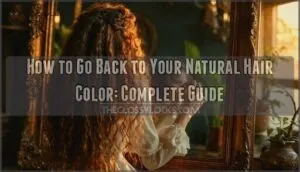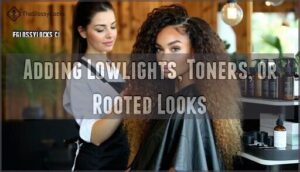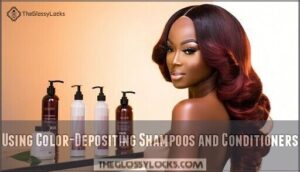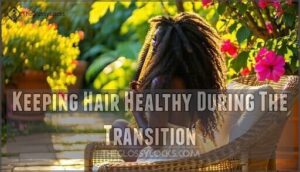This site is supported by our readers. We may earn a commission, at no cost to you, if you purchase through links.

The process requires patience, strategy, and usually some professional help, but the payoff is hair that finally feels like home. Whether you’re growing out bleach-blonde ends or erasing years of dark dye buildup, understanding the right approach for your specific situation makes all the difference between a graceful shift and months of awkward grow-out phases.
Table Of Contents
- Key Takeaways
- How to Plan Your Transition Back to Natural
- Best Methods to Remove Artificial Hair Color
- Step-by-Step Guide to Transitioning Hair Color
- Keeping Hair Healthy During The Transition
- Expert Tips for Embracing Your Natural Color
- Frequently Asked Questions (FAQs)
- What products should I use to transition my hair?
- Can I lighten or deepen my hair before transitioning?
- What treatments can be used to enhance the transition?
- How long does transitioning to natural color take?
- Can I transition without visiting a salon?
- Will going natural damage my hair further?
- How do I match my childhood hair color?
- What if my natural color has changed over time?
- Conclusion
Key Takeaways
- Transitioning to natural hair color requires professional consultation, strategic planning, and realistic timelines—expect 3-6 months and $150-$500+ per session, with your approach depending entirely on whether you’re removing semi-permanent dye (which fades naturally) or permanent color (which demands salon-grade correction).
- Your hair’s health dictates your options more than your desired outcome—colorists assess damage, scalp condition, and follicle strength before mapping your shift, because rushing the process with compromised strands only extends the awkward phase you’re trying to escape.
- Maintenance between salon visits involves strategic products like color-depositing shampoos, deep conditioning masks, and weekly trims every 8-10 weeks to prevent split ends from sabotaging your progress while silk pillowcases and targeted supplements support growth from the inside out.
- Lowlights, glosses, and rooted techniques let you blur harsh demarcation lines and skip the obvious grow-out stage, turning what could be months of awkwardness into an intentional, polished look that builds confidence throughout your journey back to authenticity.
How to Plan Your Transition Back to Natural
Going back to natural isn’t something you should wing—it takes strategy, patience, and the right team in your corner. Before you make any moves, you need a solid game plan that protects your hair and gets you the results you’re after.
Here’s what you need to lock down before your first appointment.
Booking a Professional Color Consultation
Before you dive headfirst into ditching your dyed hair, booking a professional color consultation is the smartest move you can make—it’s like getting a GPS before a road trip you’ve never taken. A skilled colorist will give you professional guidance customized to your specific situation.
During your consultation, expect:
- Hair assessment and color analysis to determine your true natural hair color
- Honest consultation tips about the best shifting to natural hair color approach
- Color planning that maps out hair color correction steps and realistic timelines
Assessing Hair and Scalp Health
Your colorist won’t just assess your dye job—they’ll examine the condition of your hair and scalp to make sure your strands can manage what’s coming next. They’ll check for hair damage, perform a thorough scalp analysis, and evaluate hair follicle health to determine if your hair texture can survive the hair color correction process.
This damage assessment reveals whether you need deep hair care interventions before shifting, protecting natural pigmentation and supporting healthy hair growth throughout your journey back.
Setting Realistic Goals and Expectations
Once you know your hair can manage what’s ahead, it’s time to get brutally honest about what "natural" really means—and how long it’ll take to get there. Shifting to natural hair color isn’t instant; embracing natural hair color takes patience, strategic hair assessment, and a realistic roadmap during your hair color shift.
Your color consultation should include goal setting and timeline planning. Expectation management is everything—your hair colorist’s advice matters here. Expect multiple sessions for dramatic shifts.
Identifying Your True Natural Hair Color
Before the hair color shift kicks into high gear, you need to know what you’re actually returning to. Natural hair color isn’t always what you remember—melanin role and hair pigment shift with age, hormones, and genetics.
Check your roots after a few months without dye, preferably at the nape where color genetics show truest. Use natural daylight and a visual examination against a professional-level chart—your natural shade might surprise you, and embracing natural hair color starts with knowing exactly what that means.
Understanding your hair color basics is essential for making informed decisions about your hair.
Researching and Choosing a Skilled Colorist
Not all colorists are created equal, and the wrong hands can turn your shift into a disaster you’ll spend months (and paychecks) trying to undo. Here’s how to find someone who actually knows color correction and natural hair color shifts:
- Check colorist credentials and salon reviews for color correction expertise—not just highlights
- Study their portfolio analysis for similar hair shift work
- Ask consultation questions about their approach to restoring natural tones
- Request expert referrals from clients who’ve completed successful shifts
Estimating Costs and Timeline
Going back to your natural shade isn’t just about the chair time—it’s about what you’ll shell out and how many weeks (or months) you’re realistically looking at before the mirror reflects the version of you that you’re after.
Budget planning for color correction usually runs $150–$500+ per session, depending on hair damage and repair needs.
Timeline estimates? Expect 3–6 months for a complete hair color shift, with salon services and products spaced strategically to protect your strands while price negotiation might save you bundled appointment costs.
Best Methods to Remove Artificial Hair Color
Getting rid of artificial color isn’t one-size-fits-all—the method you’ll need depends on what type of dye you’re working with and how committed it’s to your hair. Semi-permanent color fades naturally over time, while permanent dye demands more aggressive tactics.
Let’s break down your options, from the gentlest home remedies to the heavy-duty salon treatments that’ll get you back to square one.
Fading Semi-Permanent Dye at Home
If you’re itching to ditch that semi-permanent dye and reclaim your natural shade, you’re in luck—it’s one of the easiest color transitions you can do without stepping foot in a salon. Semi-permanent dyes gradually fade between six and eight washes, so you’ve got options:
- Wash frequently with warm water to speed up color fading
- Let it fade naturally if you shampoo less often
- Use color-safe products afterward to protect your emerging natural tone
Using At-Home Color Removers and Clarifying Shampoos
When washing alone won’t cut it, at-home color removers and clarifying shampoos can fast-track your journey back to your natural shade—think of them as the heavy hitters in your DIY arsenal. Color removers shrink dye molecules so they rinse out easier, while clarifying shampoos strip buildup that holds pigment in place.
These at-home hair color solutions offer solid fading techniques without the salon price tag, just be ready with damage repair treatments afterward since removing hair dye at home can leave strands thirsty.
Professional Salon Solutions for Permanent Dye
Permanent dye won’t budge with home tricks—you’ll need a colorist’s toolkit to reverse what chemistry locked in. Professional hair color services, like color correction and treatment, use specialized dye removal methods to strip stubborn pigment without frying your strands.
During your salon consult, a skilled colorist maps out your hair color shift, balancing hair restoration with damage control—because a permanent fix demands precision, not guesswork.
Correcting Color Mistakes With a Colorist
Color gone rogue—or just not what you signed up for—deserves a pro’s eye to bring it back from the brink. A colorist approaches color correction with targeted pigment repair and tone adjustment, unraveling botched dye jobs through strategic color correction and treatment.
They orchestrate hair restoration and damage control simultaneously, steering your color shift toward natural hair color without scorching what’s left—because shifting to natural hair color takes finesse, not panic.
Understanding Bleach and Difficult Colors
Bleach sits at the opposite end of color removal—it destroys melanin permanently, leaving behind melanin loss and hair porosity that can’t be undone. Those chemical reactions shatter the cuticle, create voids in the cortex, and strip the protective barrier your strands need.
Bleach damage means you’re working with weakened hair that won’t hold color evenly, making hair color shift back to natural tricky. Black dye and vivid reds cling stubbornly, resisting removal and complicating color correction without pro intervention.
Understanding the effects of hair bleach damage is essential for a successful color shift.
Step-by-Step Guide to Transitioning Hair Color
Now that you’ve tackled the removal phase, it’s time to map out your actual shift strategy. The method you choose depends entirely on where you’re starting and where you want to end up.
Here’s how to navigate each common scenario without wrecking your hair in the process.
Transitioning From Blonde, Brunette, Red, or Fantasy Colors
The path back to your natural shade depends entirely on where you’re starting—and blonde, brunette, red, and fantasy colors each come with their own set of rules.
Blondes need subtle shade matching through toners or strategic lowlights for natural tones. Brunettes going lighter require honest hair colorist advice about damage risks during color shift.
Reds often need color correction to lift orange pigment before pigment restoration begins. Fantasy colors benefit most from shifting to natural hair color using rooted techniques that support healthy hair regrowth.
Adding Lowlights, Toners, or Rooted Looks
Once you’ve picked your method, lowlights, toners, or rooted techniques give you the control to soften those harsh lines and blend your way back without the shock of an overnight change. Lowlights technique builds natural depth by weaving darker tones through lighter sections, while toner application neutralizes brassy tones during your hair color shift. Rooted color creates dimensional layers that grow out gracefully.
- Lowlights: Add richness without committing to full color treatment
- Toning: Adjust your shade and eliminate unwanted undertones
- Rooted looks: Embrace strategic grow-out for smooth shifting to natural hair color
Using Color-Depositing Shampoos and Conditioners
Between salon visits, color-depositing shampoos and conditioners can quietly refill your strands with pigment, keeping your tone steady while you shift out the past. Pick formulas that match your hair color shift goal—purple for blondes fighting brass, copper for reds losing vibrancy, or ash-brown for natural hair color depth.
| Hair Type | Color Depositing Product | Pigment Enhancement Goal |
|---|---|---|
| Blonde | Purple shampoo | Neutralize yellow, boost cool tones |
| Brunette | Ash-brown conditioner | Add depth, support color correction |
| Red | Copper-infused formula | Restore vibrancy and warmth |
| Fantasy shades | Color-matched treatment | Extend fade, ease hair toning process |
Use them once or twice weekly for hair care and maintenance without overdoing it.
Enhancing With Glosses and Pigment Conditioners
Glosses act like a filter on your hair—they dial down unwanted tones, smooth out rough patches from previous dye jobs, and pump shine back into tired strands without committing you to permanent color.
Your colorist can customize gloss application during your hair color shift, layering pigment depositing formulas that act as color enhancers while you ease toward your natural hair color.
These vibrance boosters perfect your hair toning between major shifts, blending color depositing power with glossing brilliance. The result? Hair color enhancement that feels natural, not harsh.
Strategic Haircuts and Trims for a Softer Grow-Out
Regular trims don’t just clean up damage—they’re your secret weapon for camouflaging that awkward line where your natural color meets the old dye job.
Ask your stylist for layered cuts with softening layers that blur harsh demarcation lines during hair shift. Hair texturizing and strategic trimming techniques work with your growth phases, turning the hair color shift into something that looks intentional, not accidental.
Keeping Hair Healthy During The Transition
Your hair’s been through a lot, and now it needs some backup while you’re growing out that color. The change phase isn’t just about waiting—it’s about protecting what you’ve got and setting yourself up for healthier natural hair on the other side.
Here’s how to keep your strands strong and minimize damage during the process.
Switching Up Your Haircare Routine
Your hair’s been through a lot—now it’s time to switch gears and treat it like the comeback kid it’s trying to be. Ditch anything that strips moisture and swap in color-safe formulas that protect what you’re building back.
Natural oils and hair serums keep moisture balance in check, while targeted hair masks repair damage from your hair shift.
Think of it as damage control with benefits—your natural hair color deserves hair care that actually shows up.
Deep Conditioning and Leave-in Treatments
If damaged hair is a brick wall, deep conditioning is the mortar that holds it together—without it, everything crumbles faster than you’d think. Use deep conditioning hair masks weekly to restore what color processing stripped away.
Leave-in products lock in moisture treatments between washes, while protein repair formulas rebuild strength from the inside out. This kind of hair treatment isn’t optional—it’s how you prevent hair damage and keep hair health on track during your natural hair growth journey.
Taking Hair Supplements and Using Silk Pillowcases
What you feed your body—and what your hair rests on at night—matters just as much as what you slather on it. Hair nutrition from within strengthens follicles and accelerates natural hair growth, while silk pillowcase materials reduce friction that causes breakage during sleep.
Build your supplement routine around these essentials:
- Biotin boosts keratin production for stronger strands
- Omega-3 fatty acids restore natural shine and elasticity
- Vitamin E protects against oxidative stress and hair health damage
- Collagen peptides support structure during regrowth
- Iron prevents shedding tied to deficiency
Silk benefits go beyond luxury—cotton absorbs moisture and creates tension that compromises hair growth and health.
Scheduling Regular Trims and Avoiding Damage
Skipping trims won’t speed up your shift—it’ll just leave you stuck with damaged ends that sabotage the healthy hair you’re working so hard to grow back.
Schedule hair trims every 8–10 weeks to eliminate split ends before they travel up the shaft, causing breakage prevention issues.
This simple hair maintenance step protects natural hair care progress and bolsters healthy growth without compromise.
Expert Tips for Embracing Your Natural Color
Going back to natural isn’t just about color—it’s about owning your decision and making the process work for you. Before you commit, you’ll want to weigh the tradeoffs, understand what’s happening beneath the surface, and build the confidence to rock your real shade.
Here’s what you need to know to make this shift feel invigorating, not overwhelming.
Pros and Cons of Going Back to Natural
Choosing to embrace your natural hair color isn’t just a beauty decision—it’s one that comes with real trade-offs you’ll want to think through before taking the plunge.
The upsides:
- Less damage, stronger strands – Your hair health improves without chemical processing, reducing hair damage risks from repeated color applications
- Real savings – You’ll slash shift costs over time by skipping salon appointments every few weeks
- Authenticity wins – Self acceptance grows when you stop hiding what’s naturally yours
- Low maintenance freedom – Natural hair color tips often emphasize simplicity once the color shift phase ends
The downsides:
- Awkward grow-out – Shifting to natural hair color means weathering that in-between stage
- Possible color regret – Not everyone loves what they rediscover underneath
Consulting a Colorist for a Blended Look
A skilled colorist can work magic with lowlights, glosses, and strategic placement to blur the harsh line between dyed and natural hair, helping you skip the awkward phase and maintain a polished look throughout the transition. Here’s what an individual approach looks like during your hair shift:
| Colorist Secrets | Natural Enhancement Technique |
|---|---|
| Hair Analysis | Examine your current shade, undertones, and natural base for accurate color matching |
| Blended Techniques | Apply balayage or rooted lowlights to soften demarcation lines |
| Custom Formulas | Mix toners and glosses adapted to your unique shifting needs |
| Timeline Mapping | Plan visits that keep you looking intentional, not accidental |
This individual approach to shifting to natural hair color ensures you remain confident at every stage.
Biological Insights on Hair Pigmentation and Restoration
When you’re shifting to natural hair color, understanding what happens beneath the surface helps explain why restoration isn’t instant. Melanin production occurs deep in your hair follicle during the growth phase, with about 100 melanocytes working to pigment each strand.
Melanin production deep in your hair follicle—with about 100 melanocytes at work—explains why natural color restoration takes time, not magic
Genetic influences control this process through over 90 gene locations, while cellular regeneration determines whether pigment restoration is even possible—especially if those melanocyte stem cells are still functional and ready to reactivate.
Building Confidence in Your Natural Hair Journey
Once you know the science behind the shift, the real challenge isn’t what’s happening inside your follicles—it’s learning to own what grows out of them. This mindful shift demands self-acceptance and inner strength as you reconceptualize your hair identity around natural beauty.
- Ditch comparison – Your natural look is yours alone, not a standard against someone else’s color shift
- Document the journey – Photos track hair health and damage while celebrating milestones in your hair color shift
- Find your tribe – Connect with others shifting to natural hair color who understand the emotional rollercoaster
- Reframe "awkward" – That grow-out phase isn’t a flaw; it’s proof you’re reclaiming authenticity
Frequently Asked Questions (FAQs)
What products should I use to transition my hair?
Ironically, chasing the perfect color often means loading up on products you’ll eventually need to undo. Focus on pigment shampoos, intermediate toners, and color depositing conditioners to gently shift your tone.
Add hair masks for damage prevention during your hair color restoration journey.
Can I lighten or deepen my hair before transitioning?
Yes—lightening or deepening before shifting can actually smooth the journey. Depth enhancement or shade adjustment creates a bridge color, making grow-out less jarring.
Color correction and hair toning soften harsh lines, especially when shifting to natural hair color from extremes.
What treatments can be used to enhance the transition?
Deep conditioning masks with pigment shampoos work wonders during a hair color shift. These color depositing products prevent damage and amplify your natural tone beautifully, keeping color correction smooth throughout the process.
Layer on gloss treatments between salon visits while taking vitamin supplements to strengthen from within.
How long does transitioning to natural color take?
Depending on your starting shade and Natural Look goals, the Hair Color Shift can span anywhere from a few weeks to over a year.
Hair Growth Rate matters—roots inch out about half an inch monthly—but the real Timeframe Expectations hinge on damage level, color intensity, and whether you’re banking on Pigment Restoration or strategic salon visits to blend your Natural Shade.
Can I transition without visiting a salon?
You can manage semi-permanent dye and some color fading at home using DIY kits, clarifying shampoos, and natural products—self-care routines aided by online tutorials.
However, permanent dye and complex Hair Color Change situations need professional help for safe Removing Hair Dye at Home results.
Will going natural damage my hair further?
Here’s the thing—color correction done right won’t wreck your hair. The chemical impact depends on your starting point and method.
Strategic transitions using lowlights, glosses, or color-safe products minimize hair damage risk while promoting hair health and wellness, preventing breakage during natural texture restoration.
How do I match my childhood hair color?
Your color memory isn’t fooling you—childhood photos reveal your true natural hue before sun exposure, genetic influence, and aging shifted your hair pigment.
Bring those snapshots to your colorist for precise hair color restoration techniques during your transformation.
What if my natural color has changed over time?
Studies suggest up to 4% of gray hairs can regain pigmentation daily—your natural hue changes as you age.
Hair Color Shift works best when your colorist matches your current Natural Hue Changes, not outdated memories, respecting Aging Hair Effects and Pigment Restoration possibilities through strategic Color Shift Causes assessment.
Conclusion
Patience pays off when you learn how to go back to your natural hair color—because rushing the process only prolongs the awkward stage you’re trying to escape. Trust your colorist, pamper your strands with deep conditioning, and remember that every trim brings you closer to authenticity.
The journey might test your patience, but reclaiming your real color means reclaiming a piece of yourself that’s been hiding beneath all that dye. Your natural hair isn’t just a destination—it’s proof you’re brave enough to be exactly who you are.
- https://www.scientificamerican.com/article/gray-hair-can-return-to-its-original-color-mdash-and-stress-is-involved-of-course/
- https://elifesciences.org/articles/67437
- https://www.popularmechanics.com/science/health/a65035876/gray-hair-could-be-reversible-study/
- https://www.cuimc.columbia.edu/news/its-true-stress-does-turn-hair-gray-and-its-reversible
- https://www.sciencedirect.com/science/article/pii/S2405844025019140











